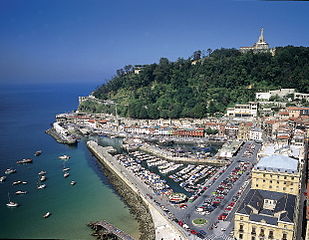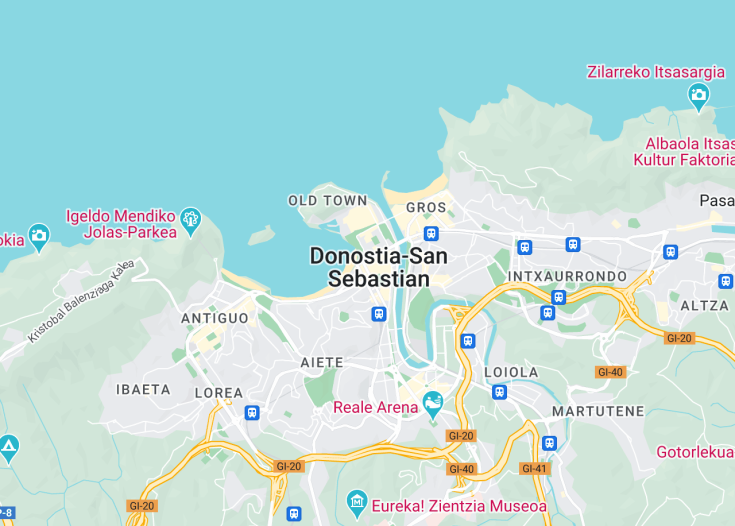Nestled on the northern coast of Spain, Donostia-San Sebastián exudes a rare blend of picturesque beaches, distinguished culinary heritage, and vibrant cultural scene. Renowned for its stunning La Concha Beach, this city is a gem of the Basque Country, offering a mix of modern allure and historical charm. Visitors can explore its rich array of architectural marvels, indulge in world-class Basque cuisine, or partake in numerous festivals that highlight its unique Basque traditions.
For the best experience, consider visiting during the San Sebastián Day in January, when the city comes alive with traditional drum parades.
Don’t miss trying the famous ‘pintxos’ in the Old Town’s bars; it’s an ideal way to delve into the local cuisine and culture.
Top things to do & see in Donostia-San Sebastian
Select the following sights and activities to discover best tickets and tours available in Donostia-San Sebastian.
Donostia-San Sebastian: A Jewel of the Basque Country
| Country | Spain |
| Time in Donostia-San Sebastian | GMT+1 |
| Language spoken | Basque, Spanish |
| Population | 186,665 (source: latest municipal register) |
| Currency | Euro (€, EUR) |
| Airports |
|
Donostia-San Sebastian, known in Basque as Donostia and in Spanish as San Sebastián, is a coastal city in Spain’s Basque Country, renowned for its beautiful beaches, vibrant cultural scene, and world-class gastronomy. This city, while being one of the most popular tourist destinations, is also a significant cultural center with deep historical roots that date back to the Roman Empire.
The city is famed for its picturesque bay of La Concha, which is flanked by lush hills and the iconic sculptural piece, the Comb of the Wind by Eduardo Chillida. Donostia-San Sebastian is not just a scenic city but also a culinary capital; it boasts a high number of Michelin-starred restaurants per square meter than any other city in the world and is famous for its pintxos, the Basque version of tapas.
The Film Festival of San Sebastián, one of the oldest and most prestigious in Europe, is another cultural highlight that draws cinema enthusiasts from around the globe every September. Furthermore, the city is a beacon of Basque culture, offering a wealth of insights into the ancient, unique language and traditions of the Basque people, making it a compelling destination for cultural tourists as well as sun-seekers and gastronomy lovers.
Where is Donostia-San Sebastian?
Donostia-San Sebastian is nestled on the northeastern coast of Spain, bordered by the Cantabrian Sea.
Distances:
| Route | Distance by car | Time by car |
|---|---|---|
| Madrid to Donostia-San Sebastian | 450 km | Approx. 5 hours |
| Barcelona to Donostia-San Sebastian | 570 km | Approx. 5 hours 30 minutes |
| Bilbao to Donostia-San Sebastian | 100 km | Approx. 1 hour |
What is Donostia-San Sebastian famous for?
Donostia-San Sebastian is celebrated for its stunning urban beaches, particularly La Concha, its vibrant cultural festivals like its renowned International Film Festival, and its exceptional culinary scene, highlighted by its numerous Michelin-starred establishments and traditional pintxos bars.
History
Prehistory to Middle Ages
The origins of Donostia-San Sebastian trace back to prehistoric times, where evidence of human presence can be seen in the numerous archaeological sites scattered around the region. It wasn’t until the 12th century, however, that Donostia-San Sebastian began to gain significance. The strategic position along the Bay of Biscay made it an ideal location for fishing and maritime trade.
12th Century – 19th Century
San Sebastián was officially founded by King Sancho VI of Navarre around 1181, aiming to fortify the coastline against foreign invasions. Called initially San Sebastián, the town developed a robust defensive wall and flourished under the Navarrese crown before coming under Castilian control. The town suffered heavily under the Napoleonic Wars in the early 19th century, leading to significant destruction and the need for substantial reconstruction.
20th Century – Present
Throughout the 20th century, Donostia-San Sebastian underwent significant transformation, evolving from a small fishing village into a renowned tourist destination. The city played a pivotal role during the Spanish Civil War and suffered considerable damage yet again. Post-war recovery was swift, and the mid-20th century onwards saw a boom in tourism, turning the city into a cultural and economic hub in the Basque region, noted for its vibrant festivals, culinary arts, and beautiful seaside scenery. The introduction of annual events like the prestigious San Sebastián International Film Festival helped solidify its global cultural significance. Today, the city thrives on its rich history, stunning architecture, and bustling gastronomic scene, continuing to attract visitors worldwide.
Visit Donostia-San Sebastian
What to see and do in Donostia-San Sebastian
Donostia-San Sebastian offers a plethora of activities and sights that cater to all types of travelers. The iconic La Concha Beach is a must-visit, renowned for its golden sands and scenic bay views. For cultural enthusiasts, the San Telmo Museoa, nestled in the heart of the Old Town, provides deep insights into Basque history and culture.
- Stroll along the vibrant La Concha promenade.
- Explore the historic Parte Vieja (Old Town).
- Visit the futuristic Kursaal Congress Centre and Auditorium.
- Enjoy panoramic views from Mount Igueldo.
- Sample traditional pintxos in local bars.
Festivals and Events in Donostia-San Sebastian
Donostia-San Sebastian is alive with festivals throughout the year. Key highlights include the San Sebastián Day in January, featuring traditional drum parades, and the renowned San Sebastián International Film Festival in September, attracting global film stars and cinema enthusiasts. The Semana Grande in August offers a week of concerts, fireworks, and cultural displays, showcasing the city’s vibrant spirit.
Best time to visit Donostia-San Sebastian
The ideal time to visit Donostia-San Sebastian is from late spring to early autumn, specifically May through September, when the weather is most favorable. These months allow full enjoyment of the city’s outdoor activities, beautiful beaches, and numerous festivals.
Is Donostia-San Sebastian worth visiting?
Indeed, Donostia-San Sebastian is worth visiting. With its rich blend of history, culture, and modern attractions complemented by stunning natural scenery, it stands as a jewel in Spain’s Basque Country. Whether you’re a history buff, a foodie, or just someone looking to relax by the beach, Donostia-San Sebastian offers a unique and enriching experience that caters to a broad spectrum of interests and tastes.









